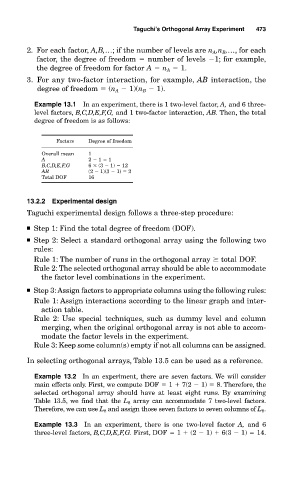Page 514 - Design for Six Sigma a Roadmap for Product Development
P. 514
Taguchi’s Orthogonal Array Experiment 473
2. For each factor, A,B,…; if the number of levels are n A ,n B ,…, for each
factor, the degree of freedom number of levels 1; for example,
the degree of freedom for factor A n A 1.
3. For any two-factor interaction, for example, AB interaction, the
degree of freedom (n A 1)(n B 1).
Example 13.1 In an experiment, there is 1 two-level factor, A, and 6 three-
level factors, B,C,D,E,F,G, and 1 two-factor interaction, AB. Then, the total
degree of freedom is as follows:
Factors Degree of freedom
Overall mean 1
A 2 1 1
B,C,D,E,F,G 6
(3 1) 12
AB (2 1)(3 1) 2
Total DOF 16
13.2.2 Experimental design
Taguchi experimental design follows a three-step procedure:
■ Step 1: Find the total degree of freedom (DOF).
■ Step 2: Select a standard orthogonal array using the following two
rules:
Rule 1: The number of runs in the orthogonal array total DOF.
Rule 2: The selected orthogonal array should be able to accommodate
the factor level combinations in the experiment.
■ Step 3:Assign factors to appropriate columns using the following rules:
Rule 1: Assign interactions according to the linear graph and inter-
action table.
Rule 2: Use special techniques, such as dummy level and column
merging, when the original orthogonal array is not able to accom-
modate the factor levels in the experiment.
Rule 3: Keep some column(s) empty if not all columns can be assigned.
In selecting orthogonal arrays, Table 13.5 can be used as a reference.
Example 13.2 In an experiment, there are seven factors. We will consider
main effects only. First, we compute DOF 1 7(2 1) 8. Therefore, the
selected orthogonal array should have at least eight runs. By examining
Table 13.5, we find that the L 8 array can accommodate 7 two-level factors.
Therefore, we can use L 8 and assign those seven factors to seven columns of L 8 .
Example 13.3 In an experiment, there is one two-level factor A, and 6
three-level factors, B,C,D,E,F,G. First, DOF 1 (2 1) 6(3 1) 14.

